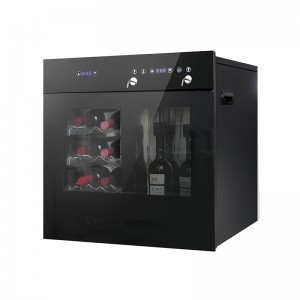Features and Function
Touch Screen
Intelligent wine dispensing
Constant temperature moisture in cabinet
Static insurance
Built-in safety gas cylinder
Temperature be adjustable
Vacuum insulation door
High end compressor refrigeration
Static sand quantitative split cup
Build In function
Keep wine fresh for 30days
Suitable for room use
Technical Parameter

Rated voltage: 220V/50 Hz 110V/60Hz
Refrigerant: R134a /R600
Cooling power: 110W
Cooling temperature: 5℃-18℃
Preservation time: Argon, Nitrogen ,within 30days
Working ambient temperature: 5℃-28℃
Product Size(mm): 600×570×595
Packing Size(mm): 650×610×625
Net weight(Kg): 35
Gross weight(Kg): 37
Tips for storing red wine after it comes in the bottle.
How long can you keep red wine after opening, refrigerated for 1week.
Once the wine has been opened and not consumed, cork it back up, place the bottle upright and keep it in the fridge for up to 1week. A plastic bag can be placed over the bottle to prevent the smell from affecting the flavor of the wine in the fridge. The temperature of the refrigerator will affect the flavor of the wine somewhat.
It can be kept at room temperature for 1-3 days.
Low-alcohol red wines can be kept at room temperature for 1 day without corking, while high-alcohol red wines can only be delayed for 3 days.
Air extraction for 2-3 days.
The use of a vacuum pump to remove the air from the bottle, or fill with inert gas can prevent the oxidation of red wine, so that the wine can be stored for 2-3 days, not more than 1 week.
The gas covers the wine and prevents the entry of air. The gas covers the wine and prevents the entry of air for storage purposes.
Inert gas preservation technology, from the Inert gas preservation technology has evolved from the days of the inert gas barrier to the current mainstream era of inert gas replacement. Although The inert gas technology, from the days of the inert gas barrier to the current mainstream inert gas replacement, has gradually solved the problem of wine oxidation, but it has also led to inert gases being pressed into the wine and causing damage to the wine's molecular structure, This affects the taste and quality of the wine and is one of the most important aspects of wine preservation. The industry has long been looking for ways to break through this problem.
The industry has long been searching for a way to break through this problem and to achieve The industry has long been looking for ways to break through this problem in order to preserve the freshness of wine!







